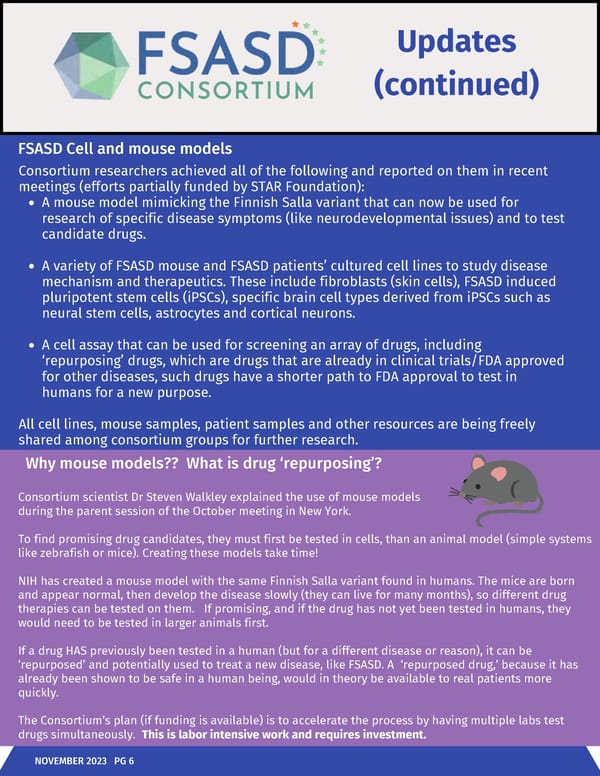Updates (continued) FSASD Cell and mouse models Consortium researchers achieved all of the following and reported on them in recent meetings (efforts partially funded by STAR Foundation): A mouse model mimicking the Finnish Salla variant that can now be used for research of specific disease symptoms (like neurodevelopmental issues) and to test candidate drugs. A variety of FSASD mouse and FSASD patients’ cultured cell lines to study disease mechanism and therapeutics. These include fibroblasts (skin cells), FSASD induced pluripotent stem cells (iPSCs), specific brain cell types derived from iPSCs such as neural stem cells, astrocytes and cortical neurons. A cell assay that can be used for screening an array of drugs, including ‘repurposing’ drugs, which are drugs that are already in clinical trials/FDA approved for other diseases, such drugs have a shorter path to FDA approval to test in humans for a new purpose. All cell lines, mouse samples, patient samples and other resources are being freely shared among consortium groups for further research. Why mouse models?? What is drug ‘repurposing’? Consortium scientist Dr Steven Walkley explained the use of mouse models during the parent session of the October meeting in New York. To find promising drug candidates, they must first be tested in cells, than an animal model (simple systems like zebrafish or mice). Creating these models take time! NIH has created a mouse model with the same Finnish Salla variant found in humans. The mice are born and appear normal, then develop the disease slowly (they can live for many months), so different drug therapies can be tested on them. If promising, and if the drug has not yet been tested in humans, they would need to be tested in larger animals first. If a drug HAS previously been tested in a human (but for a different disease or reason), it can be ‘repurposed’ and potentially used to treat a new disease, like FSASD. A ‘repurposed drug,’ because it has already been shown to be safe in a human being, would in theory be available to real patients more quickly. The Consortium’s plan (if funding is available) is to accelerate the process by having multiple labs test drugs simultaneously. This is labor intensive work and requires investment. NOVEMBER 2023 PG 6
 2023 Progress Report Page 6 Page 8
2023 Progress Report Page 6 Page 8